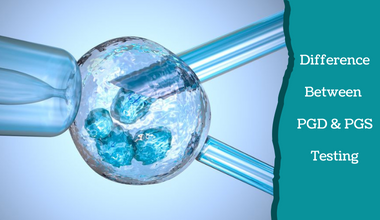Today a couple undergoing reproductive treatment such as IVF may be encouraged to have their embryos genetically tested. Preimplantation genetic diagnosis (PGD) and Preimplantation Genetic Screening (PGS) are two tests performed on embryos . Only embryos with no genetic abnormalities are put in the woman’s uterus after the tests. With the use of PGS of embryos, IVF success rates have increased dramatically. A skilled embryologist must remove a biopsy of a blastocyst embryo to provide genetic results of an embryo. In this article, here are the lists of differences between these types of testing.
What is preimplantation genetic screening (PGS)?
Genetic testing before implantation PGS is now often known as PGT-A. This test looks for chromosomal abnormalities in embryos. An embryo with 46 chromosomes is chromosomally normal, and any departure from this amount increases the chances of botched implantation, miscarriage, or a viable chromosome syndrome such as Down syndrome. Chromosomal abnormalities are rather prevalent, despite their worrying nature. A chromosomal defect is found in over a third of all embryos from a 30-year-old woman. By the time a woman reaches the age of 40, this proportion has risen to nearly 80% abnormal. As a result, compared to a younger woman, women who try to conceive later in life may have more difficulty conceiving, a higher risk of miscarriage, and a higher risk of having a child with a genetic condition like Down syndrome. As a result, endocrinologists frequently advise women in their late thirties or early forties to undertake PGS.
What is the preimplantation genetic diagnosis (PGD)?
PGD, also known as preimplantation genetic diagnosis testing for monogenic illnesses, is a type of preimplantation genetic testing. Suppose a couple has a known genetic condition in their family caused by a single gene mutation. In that case, PGD testing IVF can be used to test each embryo to see if it has acquired the mutation and disease propensity. When both the egg source and the sperm source are carriers of the same autosomal recessive illness, this embryo testing can be used to see if their embryos have inherited both mutations.
How is testing performed?
- A biopsy of cells it is from a blastocyst embryo is required for both PGS and PGD. The operation is known as embryo biopsy and is performed frequently in embryology labs. Although most embryos survive the biopsy, there is a slight possibility that an embryo will stop growing after the biopsy. There are no studies that show that embryos that have been biopsied have a higher risk of birth abnormalities than embryos that have not been biopsied.
- The biopsied cells are sent to the lab for testing, while the blastocyst embryo is frozen and kept until the findings are received. The patient can next devise a strategy for utilizing the stored embryos. When the patient receives the results, they will consult with their doctor to choose an embryo for future transfer. Most doctors would advise the couple to select an embryo that is clear of chromosomal abnormalities.
What you should know about PGS and PGD:
- These tests are not required as part of the IVF procedure. As a result, the cost of these tests is often not included in the cost of an IVF cycle.
- Both of these tests require an amniotic fluid sample, typically taken three days after the embryo has been cultured. The embryo’s health is jeopardized when this sample is taken, and if the embryo is injured, the pregnancy will not be successful.
- In addition, PGS testing IVF results necessitate the collection of samples for 5 to 6 embryos, which might not be possible in a single IVF cycle for older women.
- As a result, these ladies may need more than one IVF round to produce enough embryos for testing.
Finally, there are a variety of criteria that influence which exam a couple should take. It is most important to deal with a reputable reproductive clinic with experienced specialists and only undergo these tests if necessary.








